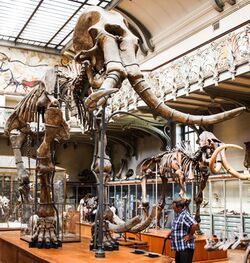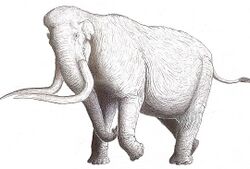Biology:Mammuthus meridionalis
| Mammuthus meridionalis | |
|---|---|

| |
| Mounted skeleton, Muséum national d'Histoire naturelle, Paris | |
| Scientific classification | |
| Domain: | Eukaryota |
| Kingdom: | Animalia |
| Phylum: | Chordata |
| Class: | Mammalia |
| Order: | Proboscidea |
| Family: | Elephantidae |
| Genus: | †Mammuthus |
| Species: | †M. meridionalis
|
| Binomial name | |
| †Mammuthus meridionalis (Nesti, 1825)
| |
| Synonyms | |
| |
Mammuthus meridionalis, sometimes called the southern mammoth, is an extinct species of mammoth native to Eurasia, including Europe, during the Early Pleistocene, living from around 2.5 million years ago to 800,000 years ago.
Taxonomy
Mammuthus meridionalis was originally named by Filippo Nesti in 1825 as Elephas meridionalis based on remains collected from the Upper Valdarno region in Tuscany, Italy.[1]
The taxonomy of extinct elephants was complicated by the early 20th century, and in 1942, Henry Fairfield Osborn's posthumous monograph on the Proboscidea was published, wherein he used various taxon names that had previously been proposed for mammoth species, including replacing Mammuthus with Mammonteus, as he believed the former name to be invalidly published.[2] Mammoth taxonomy was simplified by various researchers from the 1970s onwards, all species were retained in the genus Mammuthus, and many proposed differences between species were instead interpreted as intraspecific variation.[3] The name Archidiskodon meridionalis is retained by some Russian researchers.[4][5]
Description
thumb|left|Complete skeleton in the Museo Nazionale d'Abruzzo, Italy
M. meridionalis was a large proboscidean, exceeding modern elephants in size.[6] A mature adult male known from a mostly complete skeleton displayed at Forte Spagnolo, L'Aquila, Italy, estimated to be approximately 4 m (13.1 ft) tall in the flesh, was volumetrically estimated to weigh 11.4 tonnes (12.6 short tons).[7] Such sizes are suggested to have been typical for males of this species.[6] Like modern elephants females were considerably smaller, with estimated average adult shoulder height of 3.3 m (10.8 ft) and a weight of around 7 tonnes (7.7 short tons).[8]
The skull was prominently domed, though the height of the dome was lower than later mammoth species. The head represented the highest point of the animal. The body was broad and the back was noticeably sloped. It had robust, elongated twisted tusks, common of mammoths.[8] Its molars had low crowns[9] and around 13 thick enamel ridges (lamellae) on the third molars, substantially lower than the number in later mammoth species.[10] M. meridionalis in relatively warm climates, which makes it more probable that it lacked dense fur.[9] The ears are also suggested to have been medium-large sized, with the tail being shorter than living elephants but longer than later mammoth species.[8]
Later European M. meridionalis populations differ from early representatives of the species by having shorter and taller skulls and mandibles, differing shapes of the temporal fossa, orbits and tusk alveoli (sockets), and an increase in the number of lamellae on the teeth and tooth crown height (hypsodonty).[11]
Habitat and diet
Fossilized plants found with the remains show that M. meridionalis was living in a time of mild climate, generally as warm or slightly warmer than Europe experiences today. Some populations inhabited woodlands, which included oak, ash, beech and other familiar European trees, as well as some that are now exotic to the region, such as hemlock, wing nut and hickory. Complete skeletons are in Stavropol State Museum in Russia , in L'Aquila National Museum and in Firenze at the Museo di Storia Naturale di Firenze in Italy. Further east, discoveries at Ubeidiya (Israel) and Dmanisi (Georgia) show the early mammoth living in a partially open habitat with grassy areas.[9]
Dental microwear of the teeth of M. meridionalis suggest that the species was a variable mixed feeder, that consumed both grass and browse, with its diet varying according to local conditions, with some populations exhibiting browse-dominated mixed feeding, while others grass-dominant.[12]
During the early part of its existence in Europe, it existed alongside the "tetralophodont gomphothere" Anancus arvernensis. Dietary analysis based on microwear suggests that there was niche partitioning between the two species, with M. meridonalis occupying more open habitats.[13]
Evolution
Since many remains of each species of mammoth are known from several localities, it is possible to reconstruct the evolutionary history of the genus through morphological studies. Mammoth species can be identified from the number of enamel ridges (or lamellar plates) on their molars: primitive species had few ridges, and the number increased gradually as new species evolved to feed on more abrasive food items. The crowns of the teeth became deeper in height and the skulls became taller to accommodate this. At the same time, the skulls became shorter from front to back to minimise the weight of the head.[14][15]
Mammuthus meridionalis is thought to descend from Mammuthus rumanus, the oldest mammoth species known outside of Africa, with the earliest records of M. meridionalis dating to around 2.6-2.5 million years ago.[14] Some early members of M. meridionalis spanning from 2.6-2.0 million years ago were historically assigned to the species M. gromovi, which some authors have regarded as the subspecies M. meridionalis gromovi.[14][11] A population of M. meridionalis evolved into the steppe mammoth (M. trogontherii) with 18–20 third molar ridges in eastern Asia, prior to 1.7 million years ago.[10] The Columbian mammoth (M. columbi) evolved from a population of M. trogontherii that had crossed the Bering Strait and entered North America about 1.5 million years ago, and not M. meridionalis as has been historically suggested.[10][16][17] European M. meridionalis specimens from around 2-1.7 million years ago are assigned to the subspecies M. meridionalis meridionalis. Advanced late Early Pleistocene populations of M. meridionalis in Europe, spanning from around 1.7-0.8 million years ago are assigned to the subspecies M. meridionalis vestinus (including the likely synonym M. meridionalis depereti) and M. meridionalis tamanensis. These two subspecies may be synonymous with each other.[11] Steppe mammoths replaced M. meridionalis in Europe in a diachronous mosaic pattern at the end of the Early Pleistocene, between around 1 and 0.8-0.7 million years ago, which was also co-incident with the arrival of the straight-tusked elephant (Palaeoloxodon antiquus) into Europe.[14][11]
Relationship with humans
At the Fuente Nueva-3 and Barranc de la Boella sites in Spain, dating to approximately 1.3 and 1-0.8 million years ago respectively, remains of M. meridionalis are associated with stone tools (in the latter site of the Acheulean type), primarily lithic flakes. At Barranc de la Boella, some rib bones possibly bear cut marks, but at Fuente Nueva-3, which has poorly preserved bone surfaces, no cuts marks have been found. Both sites are suggested to represent evidence of butchery by archaic humans.[18]
References
- ↑ Palombo, Maria R.; Ferretti, Marco P. (January 2005). "Elephant fossil record from Italy: knowledge, problems, and perspectives" (in en). Quaternary International 126-128: 107–136. doi:10.1016/j.quaint.2004.04.018. https://linkinghub.elsevier.com/retrieve/pii/S1040618204000801.
- ↑ Osborn, H. F. (1942). Percy, M. R.. ed. Proboscidea: A monograph of the discovery, evolution, migration and extinction of the mastodonts and elephants of the world. 2. New York: J. Pierpont Morgan Fund. pp. 1116–1169. https://archive.org/stream/proboscideamonog02osbo#page/1116/mode/2up.
- ↑ Maglio, V. J. (1973). "Origin and evolution of the Elephantidae". Transactions of the American Philosophical Society 63 (3): 1–149. doi:10.2307/1379357.
- ↑ Shchelinsky, V.E. (April 2020). "Large mammal hunting and use of aquatic food resources in the Early Palaeolithic (finds from Early Acheulean sites in the southern Azov Sea region)" (in en). Quaternary International 541: 182–188. doi:10.1016/j.quaint.2020.04.008.
- ↑ Baigusheva, Vera S.; Titov, Vadim V.; Foronova, Irina V. (October 2016). "Teeth of early generations of Early Pleistocene elephants (Mammalia, Elephantidae) from Sinyaya Balka/Bogatyri site (Sea of Azov Region, Russia)". Quaternary International 420: 306–318. doi:10.1016/j.quaint.2015.08.007. ISSN 1040-6182. Bibcode: 2016QuInt.420..306B.
- ↑ 6.0 6.1 Larramendi, A. (2016). "Shoulder height, body mass and shape of proboscideans". Acta Palaeontologica Polonica 61. doi:10.4202/app.00136.2014. https://www.app.pan.pl/archive/published/app61/app001362014.pdf.
- ↑ Romano, Marco; Manucci, Fabio; Antonelli, Matteo; Rossi, Maria Adelaide; Agostini, Silvano; Palombo, Maria Rita (2022-07-14). "In vivo restoration and volumetric body mass estimate of Mammuthus meridionalis from Madonna della Strada (Scoppito, L'Aquila)". Rivista Italiana di Paleontologia e Stratigrafia 128 (3). doi:10.54103/2039-4942/16665. ISSN 2039-4942. https://riviste.unimi.it/index.php/RIPS/article/view/16665.
- ↑ 8.0 8.1 8.2 Larramendi, Asier; Palombo, Maria Rita; Marano, Federica (2017). "Reconstructing the life appearance of a Pleistocene giant: size, shape, sexual dimorphism and ontogeny of Palaeoloxodon antiquus (Proboscidea: Elephantidae) from Neumark-Nord 1 (Germany)". Bollettino della Società Paleontologica Italiana (3): 299–317. doi:10.4435/BSPI.2017.29. ISSN 0375-7633. https://www.paleoitalia.it/wp-content/uploads/2021/08/01_Larramendi_et_al_2017_BSPI_563.pdf.
- ↑ 9.0 9.1 9.2 Lister, Adrian; Bahn, Paul (2007). Mammoths: giants of the ice age. Frances Lincoln LTD. pp. 25–26. ISBN 9780711228016. https://books.google.com/books?id=6bhLvgAACAA.
- ↑ 10.0 10.1 10.2 Lister, A. M.; Sher, A. V. (2015-11-13). "Evolution and dispersal of mammoths across the Northern Hemisphere". Science 350 (6262): 805–809. doi:10.1126/science.aac5660. PMID 26564853. Bibcode: 2015Sci...350..805L.
- ↑ 11.0 11.1 11.2 11.3 Konidaris, George E.; Kostopoulos, Dimitris S.; Koufos, George D. (2020-03-12). "Mammuthus meridionalis (Nesti, 1825) from Apollonia-1 (Mygdonia Basin, Northern Greece) and its importance within the Early Pleistocene mammoth evolution in Europe". Geodiversitas 42 (6): 69. doi:10.5252/geodiversitas2020v42a6. ISSN 1280-9659. https://bioone.org/journals/geodiversitas/volume-42/issue-6/geodiversitas2020v42a6/Mammuthus-meridionalis-Nesti-1825-from-Apollonia-1-Mygdonia-Basin-Northern/10.5252/geodiversitas2020v42a6.full.
- ↑ Rivals, Florent; Semprebon, Gina M.; Lister, Adrian M. (September 2019). "Feeding traits and dietary variation in Pleistocene proboscideans: A tooth microwear review" (in en). Quaternary Science Reviews 219: 145–153. doi:10.1016/j.quascirev.2019.06.027. https://linkinghub.elsevier.com/retrieve/pii/S0277379119302641.
- ↑ Rivals, Florent; Mol, Dick; Lacombat, Frédéric; Lister, Adrian M.; Semprebon, Gina M. (2015-08-27). "Resource partitioning and niche separation between mammoths (Mammuthus rumanus and Mammuthus meridionalis) and gomphotheres (Anancus arvernensis) in the Early Pleistocene of Europe" (in en). Quaternary International. Mammoths and their Relatives: VIth International Conference, Grevena-Siatista, Greece, part 1 379: 164–170. doi:10.1016/j.quaint.2014.12.031. ISSN 1040-6182. Bibcode: 2015QuInt.379..164R. https://www.sciencedirect.com/science/article/pii/S1040618214009860.
- ↑ 14.0 14.1 14.2 14.3 Lister, A. M.; Sher, A. V.; Van Essen, H.; Wei, G. (2005). "The pattern and process of mammoth evolution in Eurasia". Quaternary International 126–128: 49–64. doi:10.1016/j.quaint.2004.04.014. Bibcode: 2005QuInt.126...49L. http://doc.rero.ch/record/13496/files/PAL_E277.pdf.
- ↑ Ferretti, M. P. (2003). "Structure and evolution of mammoth molar enamel". Acta Palaeontologica Polonica. 3 48: 383–396.
- ↑ Enk, J.; Devault, A.; Widga, C.; Saunders, J.; Szpak, P.; Southon, J.; Rouillard, J. M.; Shapiro, B. et al. (2016). "Mammuthus population dynamics in Late Pleistocene North America: divergence, phylogeography, and introgression". Frontiers in Ecology and Evolution 4. doi:10.3389/fevo.2016.00042.
- ↑ van der Valk, Tom; Pečnerová, Patrícia; Díez-del-Molino, David; Bergström, Anders; Oppenheimer, Jonas; Hartmann, Stefanie; Xenikoudakis, Georgios; Thomas, Jessica A. et al. (17 February 2021). "Million-year-old DNA sheds light on the genomic history of mammoths" (in en). Nature 591 (7849): 265–269. doi:10.1038/s41586-021-03224-9. ISSN 1476-4687. PMID 33597750. Bibcode: 2021Natur.591..265V.
- ↑ Haynes, Gary (March 2022). "Late Quaternary Proboscidean Sites in Africa and Eurasia with Possible or Probable Evidence for Hominin Involvement" (in en). Quaternary 5 (1): 18. doi:10.3390/quat5010018. ISSN 2571-550X.
Bibliography
- Lister, A.; Bahn, P. (2007). Mammoths - Giants of the Ice Age (3 ed.). London: Frances Lincoln. ISBN 978-0-520-26160-0. https://books.google.com/books?id=diTwAAAAMAAJ.
External links
Wikidata ☰ Q550390 entry
 |




